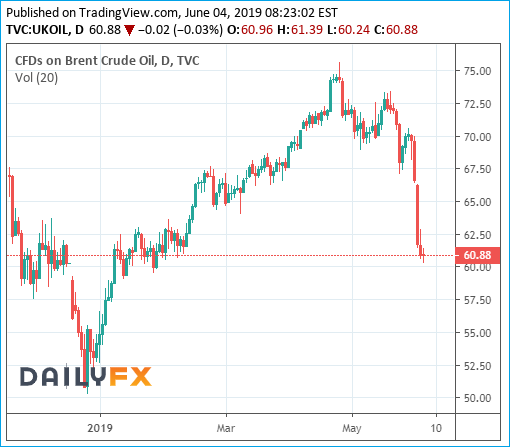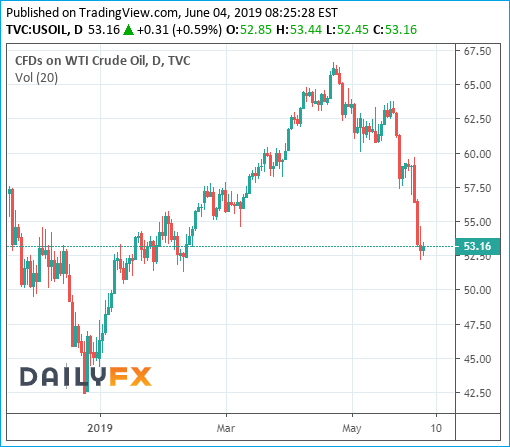Oil prices’ free fall has temporarily stopped – after Saudi Arabia hinted that the OPEC cartel would let its production cut stays for a while. Nevertheless, there has been chaos and panic among oil producing countries in recent days. In just 3 days (Thursday to Monday), the crude oil plunged from above US$70 to below US$61 a barrel.
Oil prices fell on Tuesday primarily due to the deep concerns of a global economic slowdown. Bank of America Merrill Lynch warned – “Slowing economic activity now threatens to derail our base case of robust cyclical (oil) demand growth.” It’s not rocket science that the economic slowdown will reduce fuel consumption. And it appears the US-China trade war has gotten worse.
With a record of 6 super-tankers scheduled for loading at the Louisiana Offshore Oil Port between late May and early June, U.S.’ surging oil production and export aren’t helping the crude oil prices. The tension between the U.S. and China was already bad enough. When Trump suddenly threatened to slap 5% (which could increase to 25%) of Mexican goods, oil prices went into meltdown.


America continues to push itself as the world’s biggest crude producer, even as Saudi-led OPEC and allies such as Russia struggle over production cut. The U.S. produced 12.3 million barrels per day at the end of May, as compared to Russia’s 11.11 million barrels and Saudi’s 9.65 million barrels.
South Korea’s economy is worsening after its GDP (gross domestic product) contracted by 0.4% in the January-March period from the previous quarter – faster than an estimated 0.3% decline. Exports shrank by 9.4% in May as demand for semiconductors plunged. “The most important thing is semiconductor prices, which continue to fall, and that implies any recovery in demand will be difficult even in the second half,” – said an economist.
For the first time since August 2016, the invincible Singapore’s factory activity shrinks when its Purchasing Managers’ Index (PMI), a key barometer of activity in the manufacturing industry, slipped 0.4 points to 49.9 last month from April – dipping below 50. A reading above 50 is essential to show that the manufacturing economy is expanding.

The data from Singapore is particularly important because it shows not only its seventh consecutive month of contraction in the electronic sector due to US-China trade war, but also the global fall in technology demand. Singapore is expected to experience the sharpest economic slowdown in Southeast Asia, with its GDP growth to slow from 3.1% in 2018 to 1.9% this year.
But the weakening factory activity was not confined to Southeast Asia, or even Asia, alone. Thanks to trade war, the U.S. and Europe also experienced slowness in factory activity. The America manufacturing activity growth, as measured by the Institute for Supply Management (ISM), showed a reading of 52.1 – a surprise decline and the worst showing since October 2016.
Heck, even the U.S. Markit Purchasing Managers’ Index (PMI) was at its lowest level since the 2008-2009 global financial crisis. The Eurozone manufacturing PMI shows a reading of 47.7 – a continuous contraction since the factory activity tumbled below 50.0 in February when it hit 49.2. From March until May, the European PMI has been registering below 48.

German manufacturing remained in a slump since the second half of January this year. The Europe’s largest economy PMI data has been consistently showing contraction from 49.9 in January to 44.3 in May. Economists surveyed by Consensus Economics expect the German economy to grow by 0.8% only this year, down from the 1.9% that was forecast one year ago.
China’s official manufacturing PMI for May came in at 49.4, lower than the 49.9 economists polled by Reuters. It was lower than April’s 50.1. The data shows that growth in China remains under pressure. However, on Monday (June 3), Caixin/Markit factory Purchasing Managers’ Index, a private survey of China’s factory sector, for May showed a slightly better reading of 50.2 versus 50.0 polled by Reuters.
Even India was not spared by Donald Trump’s combative trade policies. Last Friday, the U.S. president unexpectedly terminated India’s designation as a developing nation, effectively eliminating an exception that allowed the country to export nearly 2,000 products to the United States duty-free. About US$5.7 billion in imports in 2017 enjoyed the preferential treatment.

So, a global slowdown, along with U.S. strong oil production, together with trade wars which Trump declares not only with China, but also allies – from Europe to Asia to North America – would more than neutralize the crude oil pressure due to sanctions on Iran and Venezuela, as well as production cut by OPEC and non-OPEC country like Russia.
Other Articles That May Interest You …
- As Trump Uses Tariffs To Fight Immigration War With Mexico, China Raises Doubts About U.S.’ Trustworthiness
- How Trade War Creates “Garbage Crisis” – After China, Now Philippines & Malaysia Reject The West’s Trash
- From Trade War To Tech War – After 5G Technology, The US Aims To Cripple China’s Artificial Intelligence
- Watch Out Trump!! – China May Weaponize “Rare Earth” To Retaliate Against U.S.’ Ban On Huawei
- China’s New Message To The U.S. – “Negotiate – Sure!”, “Fight – Anytime!”, “Bully Us – Dream On!”
- Trump Is Bluffing – He Will Not Let The Stock Market Collapse, And He Lied About Forcing China To Pay $100 Billion
- Trump’s May 1 Deadline – But Not All Countries Will Obey The US’ Order To Stop Buying Oil From Iran
- Forget OPEC – These 3 Powerful Men Will Determine & Control The World Oil Prices
- China Reveals Strategy To Fight U.S. Trade War – Stop Buying American Debt

|
|
June 4th, 2019 by financetwitter
|


|

|

|

|

|

|




























Comments
Add your comment now.
Leave a Reply